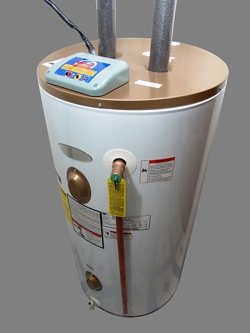Water Heater Insulation Jacket
Easy to Use Hot Water Tank Insulation
Do You Need a Water Heater Insulation Jacket? Hot water tank insulation saves big money with little effort. Here's a simple test to determine if the answer is YES.
Is a Water Heater Insulation Blanket For You?
A major source of energy loss at home is an uncovered water heater.

Most water heating systems constantly reheat the water in the tank while waiting for someone to use it. Not a super efficient use of resources.
A quick test to tell if you will benefit from a water heater insulation blanket is to feel the tank with your bare hand. If it's warm to your touch, heat is escaping and insulation will help.
Like putting a cozy on a teapot, covering your hot water tank with an insulating blanket can preserve the heat in your water for more than twice as long as an uncovered tank.
Keeping the water hot means that there is a longer time between heating cycles and for you that means dollars that stay right where they belong... in your pocket.
A properly installed insulating blanket can reduce your water heating cost by 25% to 45% depending on how well insulated your tank was in the first place, how much hot water you use and the ambient temperature in the room where the tank is installed.
Systems that are constantly in use, where hot water is being used as fast as the heater can heat it, will not see results as favorable as a system where the water is heated and then stored in the tank for a period of time in stand-by mode. If the water isn't sitting in the tank long enough to cool down, a water heater insulation blanket isn't going to make a big difference.
Owens Corning Water Tank Insulation Jacket is easy, effective and inexpensive at less than $15 USD - you're likely to save more than that on your
heating bill the very first month.
Points to Ponder
- Follow directions for applying the insulation to the tank.
- Electric tanks are usually the easiest to cover.
- Make a paper towel (tape a few together) or tissue paper template of the top of your tank, with holes for all pipes that extend out the top. Lay the paper towel on the top section (lid) of the insulating material and cut the holes into the insulation top.
- Wrap the jacket around the tank making sure that the overflow pipe and pressure valve are outside the insulating blanket. You may have to compress the blanket (or even cut it) if these structures are mounted very close to the tank. Secure blanket in place.
- Locate the access panel (which will be covered by the blanket). Find the four corners and make an X cut, from corner to corner diagonally then tuck the resulting flaps under the edge of the cover. Repeat the process for any other panels to which you need access.
- Once insulated, your tank temperature should be set at 130 degrees F or lower. We recommend 120 degrees on our energy conservation tips page (higher temperatures can damage your wiring and pose a scalding risk).
Visitors to our Water Heater Insulation Jacket page may also be interested in the following pages.
Water Pipe Insulation
Solar Water Heater
Solar Pool Heater










